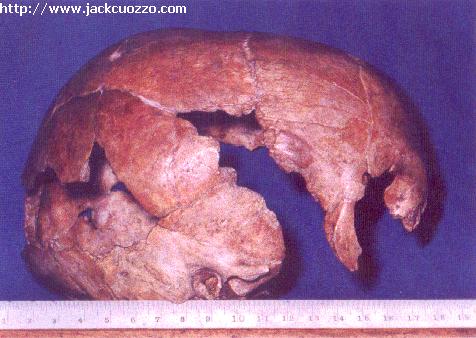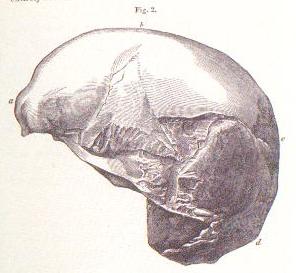Engis 2 is the skull of a Neanderthal child found in Belgium in 1829.
 |
In 1982 Dr. Cuozzo measured the Engis 2 skull, and discovered that the length was 164 mm. ("Buried Alive" pg 91) |
In 1936 Charles Fraipont had exaggerated the length of the Engis 2 skull saying it was 188 mm. long. ("Les Hommes Fossiles D' Engis")
Ann Marie Tillier in her 1983 article "Le crane d'enfant d'Engis 2" said the skull was 176 mm.
Nancy Minugh-Purvus wrote her Doctoral dissertation in 1988 under Dr. Alan Mann (see debate between Dr. Mann and Dr. Cuozzo)
In her dissertation she gives the length of the Engis 2 child as 176 mm.
Nancy Minugh-Purvus Doctoral dissertation:
| 204 - TABLE 45 | LENGTH AND BREADTH OF CRANIAL VAULT |
| Developmental Interval / Age(1) Specimen Engis 2(N) |
Max length = 176 Max Br (130) Index 74 |
She did the Engis measurements herself, because she cites other authors (2) when she has taken it from them.
What is a student to do when her measurements go against the ones published?
If they want a degree - they have to agree.
| Charles Fraipont | 188 mm. ("Les Hommes Fossiles D' Engis", 1936) | Dr. Jack Cuozzo | 164 mm. ( measurement is from 1982, "Buried Alive" pg 91, 1998) | Ann Marie Tillier | 176 mm ("Le crane d'enfant d'Engis 2", 1983) | Nancy Minugh-Purvus | 176 mm. (Doctoral dissertation, 1988) |

The real length of the skull is 164 mm, as given by Dr. Cuozzo and shown in his picture above.
It is hard to believe that others got the figures they cite from actually measuring the skull. No matter how you turn the skull you are never going to get Fraiponts measurement of 188 mm.
Why did they inflate the figures? Because if the Engis child was 188 mm like Fraipont said, then it didn't have as far to grow to reach the size of La Chappelle, and other Neanderthal adults.
To acomplish this, Neanderthals either would either have had to live longer like Dr. Cuozzo contends, or they would have had much faster growth rates than modern humans.
There is a lot of growth between the Neanderthal children and the adults. This is a record amount of growth that is best explained by longevity and the Bible.
"Either the Neanderthals had world-record rates of change in the growth of the face or this process took much more time than it does in modern children."
- Dr. Jack Cuozzo ("Buried Alive", pg 189)
Dr. Cuozzo wrote a paragraph in the research notes on page 285 [of "Buried Alive"] about an illustration that appeared in Tattersall's book "The Last Neanderthal" (pg 79, 1995).
In Tattersall's book is a diagram with a caption stating that this was the Engis child.
After checking this against Lyell's Antiquity of Man, it is clear that Tattersall made a mistake in his book.
Below is a picture from Tattersall's book, with the accompanying caption.
|
"The Engis (Belgium) juvenile Neanderthal cranium.
This partial cranium of a two - or three- year old was discovered by Philippe-Charles Schmerling in 1829. It was the first Neanderthal discovered but not identified as such until a century later. Nonetheless, it's ancientness was recognized from the start (it is now thought to be about 70 thousand years old), and this illustraion was published by Charles Lyell in 1863, in his Antiquity of Man" |
 |
Tattersall's book should state that this is the adult, not the child.
25 Nov 2001
"The cranium of the infant from /of Engis number 2"
"I would like to set the record straight about the infant cranium called Engis 2. It had been mismeasured a number of times in the past. Originally Fraipont said the overall cranial length was 188 mm. Then, Tillier said it was 176 mm followed by Minugh-Purvis, who also came up with 176 mm. The actual measurement of 164 mm was reported by me in 1998 in Buried Alive. I measured the cranium in 1982.
However, in Buried Alive, in my research notes, I wrote that Charles Lyell had said it was 195mm. This fact I took from Ian Tattersall's book, "The
Last Neanderthal". I did not check the original source from which Tattersall had taken that figure and he also used a photo of Engis I,
calling it the infant from Engis. So, I copied his mistake. I was wrong in not checking original sources and quoting a secondary author. I wish to
make this public because it points out once again the necessity of seeing original work. I wish to apologize to Chris Stringer and the British Museum
for this error.
Let me emphasize, that this is no way justifies the 188mm and 176mm measurements which I believe were accomplished with less than scientific
methods for purposes of demonstrating a growth rate more in line with modern humans. If 164 mm was ever reported by evolutionists, then, they
would have to come up with a way that the child (Engis 2) could be less than 89 percent complete in cranial length at age by 3 yrs old, or less
than 91 percent complete by 5 years old. You see Spy I the adult from Belgium was 200 mm and the Engis I adult was 195 mm. Both of these adult
cranial lengths make Engis 2's 164 mm too short for its age of 3, 4, or even 5. In contrast, 176 mm makes Engis 2's cranial length 90 percent of
Engis I and 88 percent of Spy I. That's how you achieve a normal human growth pattern out of one that is much slower like that of Neanderthal
children."
Dr. Jack Cuozzo
To furthur stress the point that Neanderthal children are not always portrayed honestly, the recent Discovery program (2001) on Neanderthals showed the Neanderthal children with large brow ridges - yet none of the Neanderthal childrens skulls exhibit this feature.
Question:
"If adult Neanderthals are simply excessively old versions of "us" then their children
would be young versions of "us" and how would we know they were neanderthal children?" -
from Wayne H.
Answer from Dr. Cuozzo:
We are only now scratching the surface of understanding their capabilities, but we know
for sure that they had stronger muscles and bones, bigger brains, better teeth, better vision, a better immune system, a slower growth
pattern with better positioning of craniofacial structures, more room in the pelvis for
their babies to pass through without the same amount of pain experienced by mothers today. Were they humans? Yes! But earlier less devolved
people than us.
This answer is derived from scientific investigation but it also satisfies the Biblical model of "Fearfully and wonderfully made"
( Psalm 139:14) and "slavery to decay" (Romans 8:21).
Neanderthal children were very slow in sexual and physical maturation, which definitely is not "us"
today. Could we ever be Neanderthals? Only by going back in time, which is the stuff of science fiction but not science or the scriptures."
"Neanderthals were not "us", neither were Neanderthal children "us" in the strict sense of the word "us". These were people with a superior genome who had the capacity to live many years who were "born different".
- Dr. Cuozzo